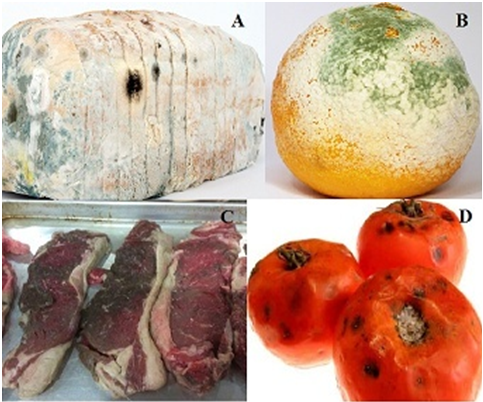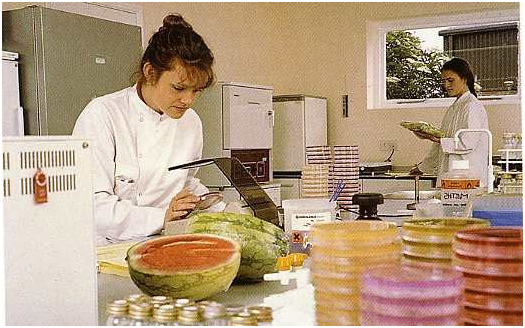What is food spoilage? Food spoilage is simply defined as the change in the overall appearance, taste and smell of a particular food or food products due to microbial activities. Food as earlier said in our previous posts contains nutrients that also support the growth of microbes especially those that are notorious in causing food spoilage.
When a particular food is no longer acceptable due to some physical changes in it, the food is said to have spoiled or undergone spoilage which is usually caused by microbes or other non-microbial factors. The factors that affect microbial spoilage of food can be either intrinsic or extrinsic in nature depending on whether the spoilage was caused by factors inherent in the food or those factors that are associated with the current environmental conditions of the food respectively.
Bacteria and fungi are the most common group of microbes that are implicated in food spoilage; and these spoilage organisms make use of nutritive factors or components of the food in question to stimulate their own growth. The condition of storage of the food, its water or moisture content level and pH as well as the presence or absence of preservatives are some factors that encourage microbial activity in food or food products thus leading to its spoilage.
When food products or food in general are properly preserved and stored, microbial activities that cause their spoilage can be properly contained; and the addition of preservative to some food products also enhances their lifespan since these additives help to inhibit possible microbial growth or activity in the food (Figure 1). It is therefore advisable to ensure proper handling, processing and storage of food and food products in order to contain microbial activity which is capable of causing their spoilage when environmental condition becomes favourable for them to thrive.

Figure 1. Illustration of microbial spoilage of some food products. A= Spoiled bread. B= Spoiled Clementine. C= Spoiled meat. D= Spoiled tomatoes.
Aside the intrinsic and extrinsic factors of food and food products that cause their spoilage; factors that has to do with the processing and production of the food as well as other implicit factors such as the relationship that occur amongst the microbial community in the food or food products are other important features that are responsible for the spoilage of a particular food/food product.
The packaging of foods, washing of the food, type of radiation used in the processing and the pasteurization technique employed during production are the main processing factors that affect the quality of food products. Microorganisms in foods can interact in several ways; and commensalism, antagonism, and synergism are some of the key types of interactions exhibited by food spoilage organisms found in a particular food or food product.
References
Bushell M.E (1998). Application of the principles of industrial microbiology to biotechnology (ed. Wiseman, A.) Chapman and Hall, New York.
Byong H. Lee (2015). Fundamentals of Food Biotechnology. Second edition. Wiley-Blackwell, New Jersey, United States.
Clark D.P and Pazdernik N (2010). Biotechnology. First edition. Elsevier Science and Technology Books, Amsterdam, Netherlands.
Farida A.A (2012). Dairy Microbiology. First edition. Random Publications. New Delhi, India.
Frazier W.C, Westhoff D.C and Vanitha N.M (2014). Food Microbiology. Fifth edition. McGraw-Hill Education (India) Private Limited, New Delhi, India.
Guidebook for the preparation of HACCP plans (1999). Washington, DC, United States Department of Agriculture Food Safety and Inspection Service. Accessed on 20th February, 2015 from: http://www.fsis.usda.gov
Hayes P.R, Forsythe S.J (1999). Food Hygiene, Microbiology and HACCP. 3rd edition. Elsevier Science, London.
Hussaini Anthony Makun (2013). Mycotoxin and food safety in developing countries. InTech Publishers, Rijeka, Croatia. Pp. 77-100.
Jay J.M (2005). Modern Food Microbiology. Fourth edition. Chapman and Hall Inc, New York, USA.
Lightfoot N.F and Maier E.A (1998). Microbiological Analysis of Food and Water. Guidelines for Quality Assurance. Elsevier, Amsterdam.
Nduka Okafor (2007). Modern industrial microbiology and biotechnology. First edition. Science Publishers, New Hampshire, USA.
Roberts D and Greenwood M (2003). Practical Food Microbiology. Third edition. Blackwell publishing Inc, USA.
Discover more from #1 Microbiology Resource Hub
Subscribe to get the latest posts to your email.



